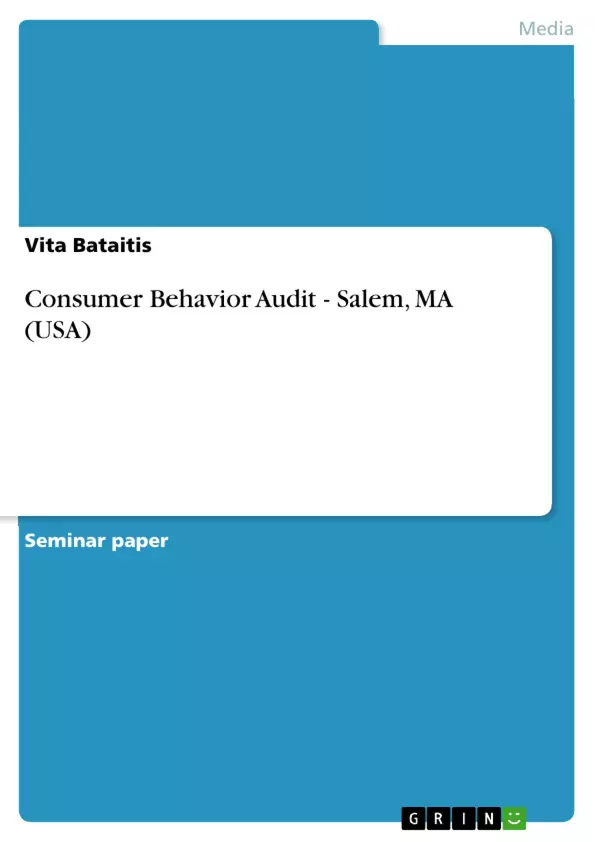Salem is a destination for about 800,000 people each year. This city has a deep history, which goes back into the 17th century and is famous for its legendary witch trials. Most people know Salem from this perspective and associate it with a historical and cultural heritage.
In addition to its historical events, Salem has much more to offer. In particular, the newly restored Peabody Essex Museum, the House of Seven Gables, an engaging seaport past, etc. are remarkable and unique places to visit. However, most tourists come during the Halloween events and stay away for the rest of the year.
Nonetheless, Salem is also internationally a known city. It should only be promoted including its true values and real heritage. Its image should be enriched and revived in order to get more consumers over the whole year.
The following consumer audit will determine potential target markets for Salem, and emphasize on particular one, which should be addressed during the next campaign. One particular target audience, which had been neglected over the years by most marketers will turn out to be the most attractive to choose. Its expenditure and consumption behavior will be studied and the decision process discussed.
The product itself, its positioning, distribution, and post purchase factors will be emphasized and brought into an association with the selected target audience.
Finally, a summary of recommendation will finish this paper.
Table of Contents
- Executive Summary
- Market Segmentation
- External influences
- Internal influences
- Situational influences
- Decision process influences
- Product Position
- Internal influences
- Decision process influences
- Pricing
- External influences
- Internal influences
- Situational influences
- Decision process factors
- Distribution Strategy
- External influences
- Internal influences
- Situational influences
- Decision process factors
- Promotion Strategy
- External factors
- Internal Factors
- Situational influences
- Decision process influences
- Product
- External influences
- Internal influences
- Situational influences
- Decision process influences
- Customer Satisfaction and Commitment
- Summary of Recommendations
Objectives and Key Themes
This consumer audit aims to identify potential target markets for Salem, Massachusetts, and focus on a specific audience to be addressed during the next marketing campaign. The audit will delve into the consumption behavior and decision-making process of the chosen target group. This will be done by considering the product itself, its positioning, distribution, and post-purchase factors in relation to the target audience. The paper will conclude with a summary of recommendations for future marketing strategies.- Identifying potential target markets for Salem.
- Analyzing the consumption behavior and decision-making process of a specific target audience.
- Exploring the product, its positioning, distribution, and post-purchase factors in relation to the chosen target market.
- Developing marketing recommendations based on the analysis.
- Enhancing Salem's image and attracting more visitors throughout the year.
Chapter Summaries
Market Segmentation
This chapter discusses the potential subcultures that align with Salem's offerings, including the Wiccan community and the Harry Potter fan base. It also explores the potential of attracting international tourists interested in history, culture, and entertainment.Product Position
This chapter focuses on how Salem's unique historical and cultural heritage can be positioned to appeal to specific target audiences. It also considers the influence of internal factors and the decision-making process in shaping consumer perceptions of Salem.Pricing
This chapter explores the factors that influence pricing strategies for Salem's offerings, including external influences, internal influences, situational factors, and the decision-making process of consumers.Distribution Strategy
This chapter examines the various distribution channels available for promoting Salem to potential tourists. It considers external factors, internal factors, situational influences, and the decision-making process in determining effective distribution strategies.Promotion Strategy
This chapter delves into the promotional strategies that can be used to attract visitors to Salem. It explores external factors, internal factors, situational influences, and the decision-making process in designing successful promotional campaigns.Product
This chapter analyzes the various products and services offered by Salem to attract tourists. It considers external influences, internal influences, situational factors, and the decision-making process in understanding how consumers perceive and choose these offerings.Customer Satisfaction and Commitment
This chapter examines factors influencing customer satisfaction and commitment to Salem as a tourist destination.Keywords
The key themes of this consumer audit are: target market identification, consumer behavior analysis, product positioning, distribution strategies, promotional campaigns, customer satisfaction, and destination marketing. The focus topics include Salem's historical and cultural heritage, the Wiccan community, Harry Potter fandom, international tourism, and effective marketing strategies for attracting visitors throughout the year.- Citar trabajo
- Vita Bataitis (Autor), 2005, Consumer Behavior Audit - Salem, MA (USA), Múnich, GRIN Verlag, https://www.grin.com/document/49099



